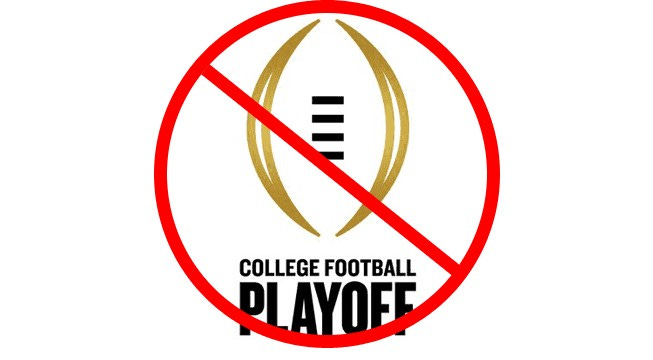The College Football Playoff Sucks; Just Copy the FCS Playoffs
Expanding to the College Football Playoff to 12 teams is a half-measure sure to infuriate traditionalists and tournament fans alike. Employ the FCS Playoffs model and move to 24.
A necessary preface to the following rant: I was never on board with the 12-team College Football Playoff. Hell, pretty early into the four-team incarnation, the event lost its luster. Semifinals often produced lousy matchups, UCF’s snubbing, Ohio State getting in ahead of a Penn State that won the Big Ten at the Buckeyes’ expense—all of it soured me on the tournament concept.
The 12-team Playoff then becoming the impetus for the Big Ten and SEC tearing conferences apart immediately made me dislike the new postseason format. The first two weekly ranking reveals have only served to steel my resolve.
Any doubt that the Big Ten and SEC, via their media partners, are angling to turn college football into an NFL Jr. with an AFC/NFC format should be gone now that those two leagues are monopolizing Playoff berths.
And maybe they deserve to occupy 8 of 12 spots. It’s difficult to know for sure, though, when some of the projected Playoff entrants from the Big Ten and SEC have played pretty underwhelming schedules thus far.
We were pitched annihilating the Pac-12 and turning the Big 12 into a less fun version of 2000s Conference USA on the bevy of dream matchups we’d get from these super-conferences. Aside from Oregon-Ohio State—who, coincidentally, played one another as non-conference opponents just three years ago—and Texas-Georgia, this season hasn’t exactly delivered on those dream contests.
I’d be remiss if I didn’t note that Michigan and Washington rebuilding after their respective runs to last year’s National Championship Game didn’t contribute to this underwhelming start to the Big 18, or that Oklahoma would experience the growing pains it has, or that USC would underachieve so dramatically.
Actually, scratch that last one. If you didn’t brace yourself for USC underachieving after the last 15 years of data, that’s a you problem.
Pac-12 Tuesday: USC and the Perpetual Pursuit of Perfection
In Alan Moore’s revolutionary 1986 comic The Watchmen, an accident during government-led nuclear testing causes the death of physicist Jonathan Osterman — and his rebirth as the atomic, godlike entity Dr. Manhattan.
And yet, it was the Big Ten adding USC that effectively killed the Pac-12. Maybe all those gobsmacking Trojans losses under Lane Kiffin, then Steve Sarkisian, then Clay Helton kicked off after the collective Big Ten leadership’s bedtimes.
Fun sidenote: Kiffin’s Ole Miss and Sarkisian’s Texas teams are both in line to qualify for this first 12-team College Football Playoff. Helton’s Georgia Southern team, meanwhile, leads its division in pursuit of a Sun Belt Championship Game berth.
But I’m getting sidetracked. The conferences aren’t entirely to blame for teams like Michigan, Washington, or Oklahoma not living up to expectations this season. However, being so bloated that breakout contenders aren’t playing one another is a problem.
Imagine how exciting a four-team round robin between surprising Indiana, Ohio State, Oregon, and Penn State this season would be. And to be sure, the aforementioned Oregon-Ohio State game as well as Ohio State’s win over Penn State provided the kind of drama one would expect from a multiple-team championship race.
Only one of the four, Ohio State, plays more than one of the rest of the quartet, barring a Big Ten Championship Game matchup. Speaking of the Big Ten Championship, here’s a scenario to consider:
Penn State loses one of its final three; a Nov. 23 road game at Minnesota seems to be the most likely candidate.
Ohio State beats Indiana on Nov. 23.
Michigan beats Ohio State the following weekend.
This guarantees Indiana a spot in the Big Ten Championship Game without it beating any of the top-tier Big Ten teams. But what’s even worse is that the Hoosiers’ Playoff prospects are probably better if they lose to Ohio State and the Buckeyes beat Michigan to set up a rematch with Oregon, than if they lose to Ohio State but still get to the conference title game.
A national championship system that could discourage competing for a conference championship isn’t a great system.
More on the subject of Indiana: It’s maddening that the justification for UCF being left out of the four-team Playoff (twice) was its strength of schedule, and now a team without a single win against an opponent with more than five wins is ranked fifth.
Different committees, different eras, blah blah blah. The underlying philosophy that kept UCF out remains the same, evidenced in Indiana sitting eight places above Boise State.
Boise State has a Top 25 win over Washington State, which Indiana does not. Boise State also played Big Ten-leading Oregon, which Indiana does not. Swap resumes, and it’s difficult to envision Boise State coming anywhere near No. 5—in part because undefeated BYU is battling with the same Big Ten/SEC monopolization.
The Cougars have wins over SMU and Kansas State, two teams within striking distance of the top 12. Using an FCS Playoffs model, both would make the field. Their positioning below Indiana is indefensible, but I suppose I owe the committee credit for clueing us into what this system’s actually going to be for its existence.
Anyway, were it not already evident in the preceding, I pretty much hate the 12-team Playoff. Longtime readers of The Press Break might know that I was a proponent of a plus-one system. Most seasons with a post-bowl season national championship controversy would have been solved using a plus-one and would have done so without stripping the history-rich bowl games of their significance.
As far as further Playoff expansion goes, though, forgive the cliches, but the horse is out of the barn. The toothpaste is out of the tube. The liquid center is out of the bowling ball. I enjoy the FCS Playoffs, and at this point, would prefer an FCS-style postseason for the FBS that guarantees every conference champion a berth in the tournament.
Borrowing from the FCS and using the committee’s terrible rankings, here’s how the College Football Playoff would look. A few notes:
The top-eight ranked teams receive first-round byes, regardless of conference standing. Ergo, a team doesn’t need to be a league champion to earn a bye.
I’m counting Pac-12-leading Washington State among the automatic bids, though the Cougars would have qualified for an at-large bid at No. 18. This is the penance the Big Ten pays for its gluttony.
Teams from the same conference can meet in the first round, but only if they didn’t face off in the regular season. Thus, No. 19 Louisville would be in line to play SMU but instead is shifted to face Boise State, while ACC counterparts SMU and Clemson meet. Colorado and Washington State are likewise swapped to avoid a K-State and Colorado rematch.
Conference championship games are scrapped to start the postseason earlier and to avoid punishing teams for reaching the conference title game and losing.
The first round, Round of 16, and quarterfinals are played on-campus at the higher seeds.
To maintain some semblance of college football tradition, the semifinals and National Championship Game will rotate among the Rose, Fiesta, and Las Vegas Bowls in the West; Sugar, Peach, and Orange Bowls in the Southeast; Alamo, Cotton, and Texas Bowls in Texas; and Lucas Oil Stadium, Ford Field, and U.S. Bank Stadium in the North.
Top Eight Seeds:
Oregon*
Ohio State
Texas*
Penn State
Indiana
BYU*
Tennessee
Notre Dame
First Round Matchups:
Miami vs. Western Kentucky* – winner plays at Notre Dame
Alabama vs. Bowling Green* – winner plays at Tennessee
Ole Miss vs. Louisiana* – winner plays at BYU
Georgia vs. Army* – winner plays at Indiana
Boise State* vs. Louisville – winner plays at Penn State
SMU* vs. Clemson – winner plays at Texas
Texas A&M vs. Colorado – winner plays at Ohio State
Kansas State vs. Washington State* – winner plays at Oregon






I have always advocated for every conference champion to get in. Going to 24 makes sense and gets everyone in who is deserving. I'd be ok going to 16 and all conference champions.